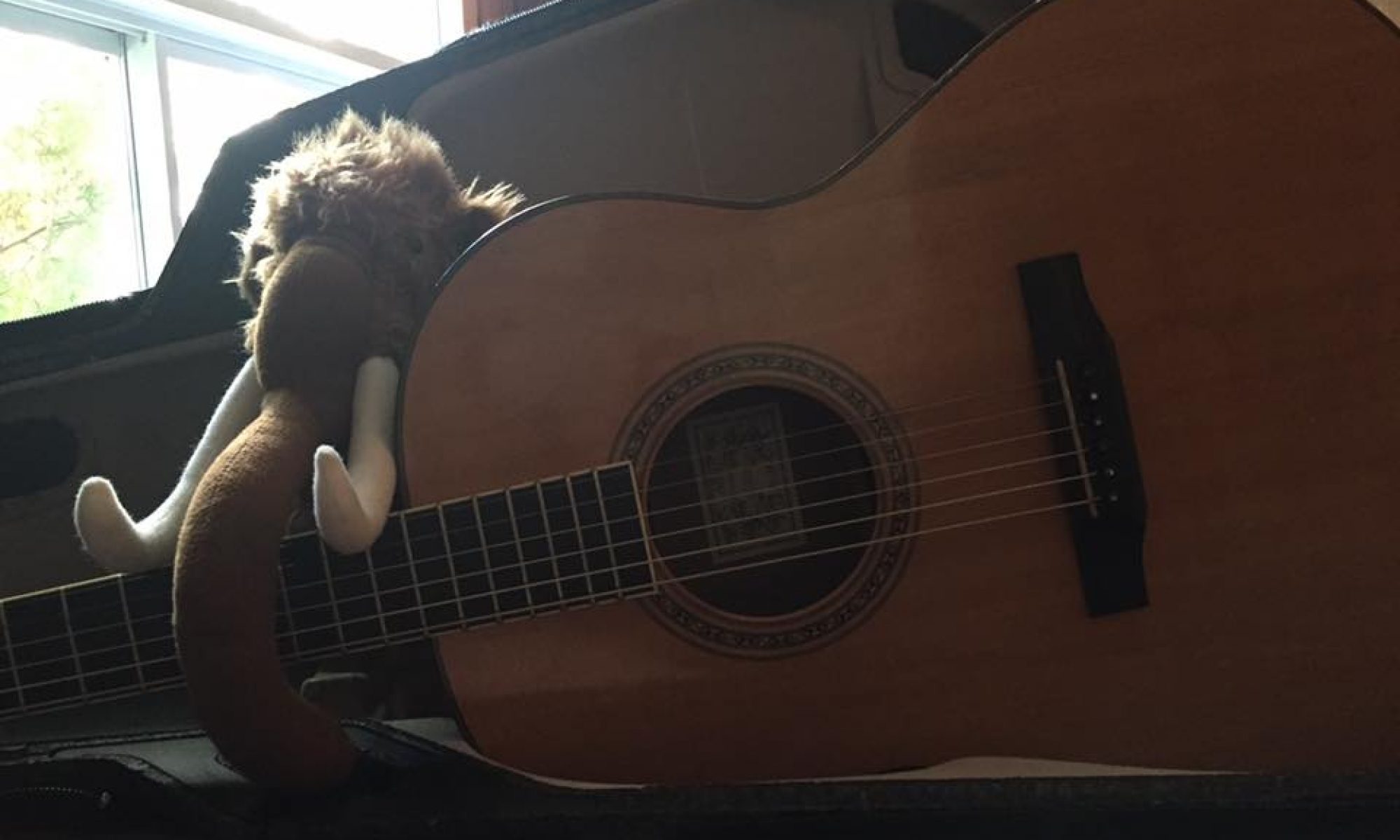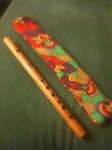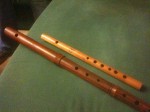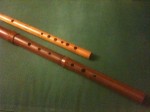It was inevitable, O Internets, that when I fell in love with the podorythmie in Quebec music, I would of course eventually have to try it myself. Those of you who have seen me post about the monthly Quebec music sessions I’ve been going to know that I’ve already tried it a time or two at those. The REAL fun, though, is if you can do it while simultaneously either singing or playing an instrument!
As I am not only a neophyte at Quebec trad but still fairly heavily out of practice on my flute in general, I ain’t expecting to get this down right out of the gate. Tonight, though, while playing with Gigue du Père Mathias, I HAD to try it. Just to see if I could.
So far what I’ve observed about podorythmie is that it’s generally done with reels (or gigues, or stuff that’s generally in 4-based time signatures). I have maybe one or two recordings where the tunes being played are clearly jigs, yet simple podo is happening underneath them–most of it, though, it’s 4-based stuff. And the very simplest rhythm I’ve been able to note thus far is a ta-ga-DAP pattern. The DAP falls on each downbeat, with the ta-ga leading into it as pickup notes (sixteenths, if you break ’em down).
Getting the pattern down with my feet is pretty easy, with the caveat of my having neither proper board nor proper shoes, so I cannot actually hear myself making the satisfying rhythm that I get in so many of the tracks I’ve got in my collection now! (Note: getting proper shoes IS an eventual goal, but I want to see if I can learn this first! ;D ) I can, however, at least get down the rhythm and the motions, and I can feel each strike of my foot against the floor even if it’s muffled.
Then comes the tricky part–trying to work in the tune to play on top of it. Since Gigue du Père Mathias is a tune I’ve now managed to memorize (and is actually the first 4-based fast tune I’ve picked up, the rest I know are all jigs so far, or waltzes, or Da Slockit Light which is I believe an air), I thought I’d try to layer that in on top of the root rhythm. I had to try it very, VERY slowly. But I thought maybe I could apply the same principle I do to trying to sing while playing guitar–i.e., don’t think about ‘your hands have to do this’ vs. ‘your feet have to do this’, but instead, get into a sort of zen space where all parts of you are uniting to make the song happen.
I think this might actually work! I tried just vocalizing the tune over my feet, and that worked okay. Then I tried actually playing it–and it took me a few tries before I got the hang of it–but I was eventually able to do the whole A part! Also, paradoxically, I did it a little better once I speeded things up a bit.
I can already tell though that this is going to be super-extra-bonus fun for a wind player. By which I mean, “oh god oh god where the hell am I going to breathe?!” It’s amusing enough to be a flute player trying to tear your way through a reel at top speed without making your legs go at the same time!
But WOW this is going to be fun. And hard. But FUN. The challenge is ON!
(STILL need a proper podorythmie icon. Must find a proper picture. And the caption will have to read ‘my fandom wears the Smiling Boots’!)
An evening of flute practice
As y’all know I’m a writer first and a musician second, but Musician!Anna is really only a few steps behind Writer!Anna, and if the instruments yell loud enough I have to pick them up. No questions asked and no quarter given. Tonight, the instruments yelled loud enough. So I grabbed Norouet and Shine for some tunes practice! (For those of you who may just be tuning in, Norouet is my current main wooden flute, and Shine is my piccolo, my oldest working instrument, from way back in my days of middle school.)
It’s been too long, so my fingers found Norouet a bit big and awkward to deal with (which of course means I damn well need to play Norouet more). So I mostly punted over to Shine instead just to review all the various tunes I know.
Started off with Road to Lisdoonvarna, including the variation I’m trying to play with. And by variation, I mostly just mean, several little additional twiddles I’m throwing in there, just to vary up the rhythm a bit and make it more interesting to listen to when I swing back around for a third repetition. Along with this, since I still typically play ’em in a set even though our Renton session imploded, I did Swallowtail Jig and Morrison’s. Morrison’s STILL gives me fits. I can’t play it at speed without losing my breath control. Augh.
Also stumbled my way through Banish Misfortune, Blarney Pilgrim, and Si Bheag Si Mhor, the other tunes from the Renton session I am still more or less able to play without having to consult sheet music.
After that, though, I jumped from Ireland over to Quebec, to practice the two tunes I was taught by Genticorum’s flute player! These tunes, y’all may or may not recall, are 6/8 de André Alain and Gigue du Père Mathias. Playing with these tonight, I determined that 6/8 de Andre Alain is more or less in my fingers. The Gigue, not so much. This is probably pretty much a direct result of how I was working with Alexandre de Grosbois-Garand on the first tune for most of our lesson, and we barely bounced off the second one.
That said, I DO have a phone recording of him playing through both of the tunes. And I have just determined that I was more or less able to follow what he was playing, at least in the slow bit of the recording. The fast bit where he kicks into full, proper tempo? Um, yeah. I gotta work on that part. *^_^*;;
The real, important takeaway here though is that yes, I apparently can learn tunes by ear if I have an opportunity to work through them a few times–either with a suitably slow recording, or with somebody with an instrument sitting with me who’s willing to fling me a few measures at a time until I can reliably echo what’s being played. And let me clarify–I can do this on the flute. And specifically on Shine, since that’s the instrument that goes back clear to my formative years, so it’s the one whose fingerings I don’t have to think about. I don’t have that level of comfort yet with flutes that don’t have keys.
(And the other takeaway here is that holy hopping gods Alexandre can play him some flute. Y’all go buy Nagez Rameurs for a proper demonstration of this! Did I mention the part where that album’s up for an award, and going head to head with Le Vent’s latest AND La Bottine’s latest as well? BEST AWARD NOMINATION LINEUP EVER. <3 )
Tune work tonight
With two brand new flutes to break in, I’ve found myself wanting to practice as well as write for the last couple of nights, and so tonight I’m doing active tune work. This means trying out all previously learned tunes on both the new instruments, as well as seeing which of the next ones work better on which instrument.
Here are an assortment of things I have thus learned.
One, there is a certain pure, clear tone that a properly played piccolo can make. I’m NOT good enough to do it consistently, but I can get there. It requires not only a good embouchure, but also that you make sure and drink enough water, which is a problem in our fairly dry, cold house! I’m learning from Chirp, though, that if I play Chirp correctly, I can in fact approach a piccolo-like tone on it. Which is pretty impressive given that Chirp is made of applewood.
Two, I like the Lisdoonvarna/Swallow Tail Jig/Morrison’s set better on Chirp than I do on the new big flute. But I like Blarney Pilgrim better on the big flute, and will probably also like Da Slockit Light and Si Bheag Si Mhor better on that one as well.
Three, I am more nimble on Chirp, unsurprisingly, since Chirp is piccolo-sized. Even though the big flute is intended for “small hands”, it’s still a bigger instrument than I’ve been used to playing for a while, and it’ll take me a bit to work back up into it. I cannot yet achieve that purity of tone I was talking about above on the big flute, not yet, not while I’m trying to also play quickly.
Four, I’m playing with Apples in Winter and Cliffs of Moher tonight, and am learning from both of these tunes that I’m trying to punch their primary beats too hard. They both want to flow better than I’m letting them do. I need to work on that. I can pick out both tunes fairly easily on the sheet music, but that’s not the same thing. Reading off the sheet music is for purposes of just learning the tunes. Finding their music, i.e., making them actually sound good, is another question entirely. I’m still working on a lot of that with all of these tunes I’m trying to learn.
Fifth, I’m also playing with Jig of Slurs, in no small part due to my interest in the “Fortierville” set on La Volée d’Castors’ so very awesome live album–and while I’m starting to get Jig of Slurs down at least as a tune, again, it’s going to be a bit before I can whip through this thing as music. Especially if I want to play along with the La Volée recording. Which I DO. Relatedly, I have also observed that at least based on comparison to that recording, I’ve been playing Chirp kind of flat.
The naming of instruments is a Serious Matter
My new applewood fife and mopane flute have now been officially broken in at session, to the satisfaction of all parties involved. Those who attended session along with and me last night (which would be , Matt, and Marilyn) expressed their approval in particular over the voice on the flute, which was very nice indeed in the pub. :D
I learned pretty quickly though that I’m not quite up to speed with my known tunes on these instruments yet. This is in no small part due to the fingerings on keyless flutes. The fife and flute both are in D, which means that the good part is, the fingerings are therefore very close to my piccolo. All fingers down means D on these instruments and on Shine alike, for example.
The bad part is, however, that the fingerings are not exactly like the fingerings on the piccolo! Shine being a concert C instrument (kicked up an octave) of course means that it’s oriented around the C scale, NOT around the D scale. So one finger down on Shine means C, not C#. I therefore will have to get the cross-fingerings for accidentals into my muscle memory on the fife and the flute in order to make these tunes work properly. Relatedly, I’ve also discovered that “Da Slockit Light” requires a G# and THAT in particular is going to be amusing to finger on these instruments.
Likewise I have learned that while the new instruments are going to be in regular session rotation, this does NOT mean Shine gets to stay home. I discovered VERY fast that if I’m trying to follow the others by finding sheet music for tunes in TunePal, I will be much, much more able to play on Shine than on either of the new guys. This is very clearly because when I see sheet music, my visual association with those notes is still solidly attached to the fingerings on keyed flutes. So next time, Shine comes to session along with the new ones.
On a much easier note though I have also discovered that the “Road to Lisdoonvarna / Swallow Tail Jig / Morrison’s” set we’ve been doing is surprisingly easier to play on the fife than it is on the piccolo. No half-holing is required for any of these tunes, and I seem to actually have an easier time playing Chirp, the fife, than I do Shine! The required embouchure is not as intense.
Which of course leads me to report that the fife is well and officially Chirp, now. The jury is still out on what to call the mopane flute, though. Ellen has opined (and I am inclined to agree) that this instrument should be named something Irish, since I am after all intending to use it primarily for Irish music, even if it’s made out of African mopane! She has proposed ‘Selkie’, which I must consider with due consideration–since this flute’s got a deep, rich voice and a deep golden brown color, both of which I could see being evocative of a selkie. I need to commune with the flute some more though and see if it agrees with me on this important matter.
Dara and I were discussing instrument names last night, too, and I shot down naming the flute either Herp OR Derp, pointing out that if any instruments in the world would be named those, they would clearly be kazoos. Dara now wants kazoos for the express purpose of naming them Herp and Derp.
And for that matter, I further opined that an accordion is too complex an instrument to be named Herp or Derp. To which Dara immediately replied that an accordion is NOT too complex to be named PAMCAKES!
I think her squeezebox has a name now.
Meet my new flutes!
Dara and I went out on a quest today: to see about getting me my first proper Irish flute!
This was actually a two-stop operation, as it turned out. Our first stop was to visit a guy named Tom in Greenlake who had some flutes for sale, to check them out and see whether they would be appropriate for me. The flutes he’s selling are Skip Healy flutes, and while they sounded lovely, it turned out that the hole placement on them was difficult for my fingers. Dara and I did have a lovely conversation about flutes and about music in general with Tom, though, and he was approving of me wanting to try different flutes before I committed to one.
Also, he had a lovely friendly black cat named Midnight, who after giving me the obligatory kitty inspection, parked right in my lap right before I was trying to take my leave. Apparently my lap? CAT MAGNET. And if anybody in the Seattle environs is in the market for a Skip Healy flute, I’ll be happy to point you in Tom’s direction.
After that, though, we went to plan B, which of course meant going to Dusty Strings. My original intent was to simply walk in and try a few flutes, just to see if any of them liked me; I wasn’t really actively expecting to find one I really liked. But then we got there and I announced what I was looking for to the nice older gentleman at the counter, and he showed me a few of the Casey Burns Folk Flutes. These were all well within my budget, and it turned out that the one made out of Mopane had a really strong voice on him. I also tried one in Boxwood, but wasn’t nearly as impressed with the sound quality of that one. Neither was Dara–and since I had her along for a second opinion, the choice was clear!
Since Dara and I can’t get out of Dusty Strings without the obligatory WOO KIDS IN CANDY MUSIC STORE run through everything, Dara played with the bouzoukis while I went and got a copy of the Mel Bay Essential Guide to Irish Flute and Tin Whistle, which I’ve been hearing is awesome from multiple directions. I also grabbed a CD by Capercaillie that was on my To Get list, as well as an assortment of various interesting picks (you can never have too many interesting picks), and last but not least, a cute little Renaissance Fife made by Ralph Sweet. The fife’s in applewood, which won out over a couple others for best clarity of tone. And even though this little guy’s really more of a toy, he’s a lot closer in size to my piccolo and therefore quite comfortable to my hands.
The big flute came with a nifty padded cloth case, but the fife didn’t come with anything, and so Dara very kindly agreed to whip together a small padded sleeve for me! She’s got a sewing machine and plenty of material, so it turned out to be very easy.
And now I give you PICS. The fife is shown next to the sleeve Dara made, as well as next to the big flute for scale. Both of these instruments are in D, and I’ve already started trying to work through the various tunes I’ve already practiced, just to figure out where all the fingerings are and to get familiar with their individual voices. Sooner or later, too, these guys will have NAMES.



